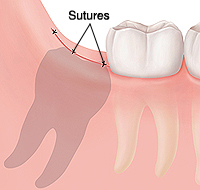Wisdom Teeth: Removal
Wisdom Teeth: Removal
Wisdom teeth are often removed (extracted) in a surgeon’s office or in an outpatient surgical center. Your experience depends on the position of the teeth, the number of teeth being removed, and other factors. Your surgeon may advise removing all of your wisdom teeth in a single procedure, even if they are not all causing problems. Or your surgeon may advise separate procedures for each side of the mouth.
Preparing for surgery
Your surgeon can tell you how long the surgery is likely to take. Including recovery from anesthesia, it may last between 45 minutes and 2 hours. Before surgery, be sure to:
Arrange time off from work or school. You’ll need a day or more to rest and begin to heal.
Tell your surgeon about any medicines you normally take. Your surgeon may advise some medicine changes.
Follow any directions you are given for not eating or drinking before surgery.
Wear loose, comfortable clothing. Choose a shirt or blouse with short sleeves. This makes it easier to put in an IV (intravenous) line.
Arrange for a ride home. An adult family member or friend should drive you home after surgery. Don’t drive yourself, and don’t take public transportation. The person who drives you should wait in the reception area during surgery.
Tell your surgeon if you have had any bad reactions to pain medicines that he plans to prescribe. Following surgery you may need prescription pain medicine.
How your tooth may be removed
A tooth can be removed in different ways. Details of the procedure will depend on:
The position of the tooth.
Whether the tooth has broken through the gum (erupted).
How deeply the tooth is embedded in the bone.
How close the roots of the tooth are to the sinuses or certain nerves or blood vessels.
Removing the tooth
An incision may be made in the gum. This creates a flap of gum tissue that can be folded back to expose the bone and the tooth. In some cases, the surgeon may be able to loosen the tooth and remove it with forceps. The tooth may need to be cut into pieces (sectioned). Bone around the tooth may also need to be removed. In rare cases, only the crown of the tooth is removed (coronectomy). After the tooth has been removed, any incision that was made is closed with stitches (sutures).
Anesthesia options
The type of anesthesia you receive depends on your surgeon’s recommendation and your preference. Your insurance coverage may also be a factor. Tell your surgeon if you have had problems with anesthesia in the past. Types of anesthesia include:
Local anesthesia. This numbs the area around the tooth to be removed. Local anesthesia is used even if another type of anesthesia is also given to you.
Sedative. This helps you stay relaxed but awake during surgery. Nitrous oxide (also called laughing gas) is one type of sedative. Other sedatives are given in pill form or by IV.
General anesthesia. This puts you to sleep during surgery. Your surgeon may advise using it if the removal is likely to be difficult. Or it may be an option if you prefer to be asleep.
Updated:
August 19, 2017
Sources:
Guideline on Pediatric Oral Surgery, American Academy of Pediatric Dentistry, Hupp, J. Contemporary Oral and Maxillofacial Surgery. 2014, pp. 159-66., Hupp, J. Contemporary Oral and Maxillofacial Surgery. 2014, pp. 88-91., Wisdom Teeth Management, American Association of Oral and Maxillofacial Surgeons
Reviewed By:
Finke, Amy, RN, BSN,Kapner, Michael, DDS
